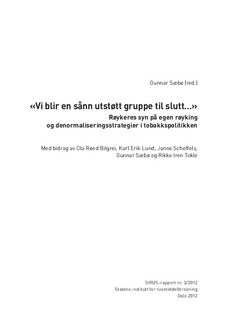| dc.contributor.author | Sæbø, Gunnar | |
| dc.contributor.author | Bilgrei, Ola Røed | |
| dc.contributor.author | Lund, Karl Erik | |
| dc.contributor.author | Scheffels, Janne | |
| dc.contributor.author | Tokle, Rikke | |
| dc.date.accessioned | 2015-01-30T14:14:07Z | |
| dc.date.accessioned | 2015-02-11T20:28:17Z | |
| dc.date.available | 2015-01-30T14:14:07Z | |
| dc.date.available | 2015-02-11T20:28:17Z | |
| dc.date.issued | 2012 | |
| dc.identifier.citation | SIRUS skrifter. 172 p. Statens institutt for rusmiddelforskning, 2012 | |
| dc.identifier.isbn | 978-82-7171-382-9 | |
| dc.identifier.uri | http://hdl.handle.net/11250/276104 | |
| dc.description | - | |
| dc.description.abstract | Denne antologien belyser røykeres syn på egen røyking. I tillegg belyses røykernes erfaringer med tobakkspolitikkens denormaliseringsstrategier.
Innledningsvis i antologien gjøres det rede for hva vi forstår med denormalisering av røyking og røykere (definering av røyking som uønsket atferd), og hvordan ideen om denormalisering har preget mye av tobakkskontrollarbeidet i Norge og i vesten forøvrig.
Rapporten presenterer så fem empiriske analyser basert på røykernes selvforståelse:
Karl Erik Lund viser i sin artikkel «Røykernes motstand til nye tobakksforebyggende tiltak» at en stor andel av dagens røykere er sterkt imot flere røykebegrensninger, særlig salgsbegrensninger for sigaretter. Motstanden er noe mindre når det gjelder nye adgangsbegrensninger.
Rikke Iren Tokles studie «Av-og-til-røyking – en dobbeltdistinksjon? Avstand fra både dagligrøyking og ‘streite’ ikke-røykere» får fram hvordan røyken inngår i det sosiale livet til urbane unge voksne, og hvordan av-og-til-røyking kan sees som uttrykk for motstand mot både avhengighetsperspektivet som assosieres med dagligrøykere og ikke-røykernes helsefokus.
I Ola Røed Bilgreis artikkel «Forsvar og motstand: Etablerte røykeres nøytraliserings- og motstandsteknikker i et tobakksfiendtlig samfunn», er det forsvaret for egen atferd og den eksplisitte motstanden mot reguleringer og myndigheter som er i fokus. Forsvaret består av nøytraliseringsteknikker for å nedtone helseplager og risiko, slik at røykingen framstår som mer legitim og rasjonell for den enkelte, mens motstanden innebærer problematisering av restriksjoner som virkemiddel og av hva som egentlig er «god helse». | |
| dc.description.abstract | The anthology sheds light on the experience of smokers with a policy of tobacco denormalization on the basis of their situation, social position and perspective. The chapters explore various aspects of the use of a hazardous product that is increasingly being defined as vulgar and ‘naff' and hemmed in by ever tighter regulations. Some of the issues that are addressed include the extent of support and backing for the measures among current smokers, and the effect of these measures and of the hostile climate on users' self-understanding and social relations.
The report starts by explaining what we understand by the denormalization of smoking and smokers, and how the idea shaped and informed efforts to control tobacco use in Norway and the West. As a policy it has been successful in the sense of reducing by a significant amount the size of the smoking population in recent decades. At the same time, however, signals emerging from several countries suggest that the policy has unintended consequences for the remaining smokers, especially a subjective experience of devalued social standing and stigmatization. Given these findings and the apparently dysfunctional effect of restrictive policies, there is obviously a need for more studies of smokers' self-understanding than has been possible up to now. This report presents five empirical analyses, all based on the user's vantage point.
To ensure that policies adopted by a society succeed, i.e., that they perform in line with expectations, it is important to determine whether there is support for the measures, not only among the general public, but among the people targeted by the policy. Karl Erik Lund, in his article on «Smokers' resistance to new tobacco control measures», notes the determined resistance of a very high proportion of current smokers to smoking restrictions, particularly restrictions on the sale of cigarettes. There is slightly less opposition to new restrictions on access. The scale of the opposition to the proposed measures is unprecedented, and may indicate significant difficulties ahead in terms of legitimizing and enforcing compliance with the measures, especially if the most controversial ones are put into effect.
The three subsequent articles discuss various strategies open to smokers in response to the denormalization policy. The first can be described as a conscious decision not to let oneself be defined as a smoker. «I'm not really a smoker» is a popular self-perception among many of the better educated partygoers and occasional smokers. In «Intermittent smoking - A double distinction? Keeping your distance from daily smokers and straight non-smokers», Rikke Iren Tokle demonstrates with great clarity how far the cigarette is woven into the social life of creative young urbanites, and how occasional smoking can express a form of resistance to the notion of dependency associated with daily smoking and the concern for health displayed by non-smokers. In light of the wider idea of denormalization, redefining smoking behaviour is seen as a way of evading binary definitions like smoker/non-smoker. | |
| dc.language.iso | nob | |
| dc.relation.uri | http://www.sirus.no/filestore/Import_vedlegg/Vedlegg_publikasjon/sirusrap.3.12.pdf | |
| dc.title | «Vi blir en sånn utstøtt gruppe til slutt...» Røykeres syn på egen røyking og denormaliseringsstrategier i tobakkspolitikken | |
| dc.title.alternative | «Vi blir en sånn utstøtt gruppe til slutt…» Røykeres syn på egen røyking og denormaliseringsstrategier i tobakkspolitikken | |
| dc.type | Research report | |
| dc.date.updated | 2015-01-30T14:14:07Z | |
| dc.identifier.cristin | 1067171 | |
